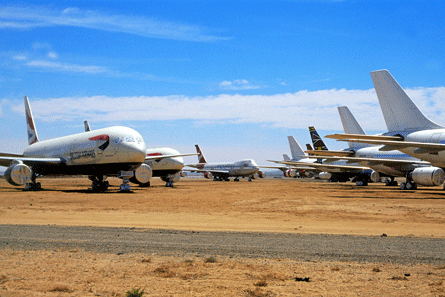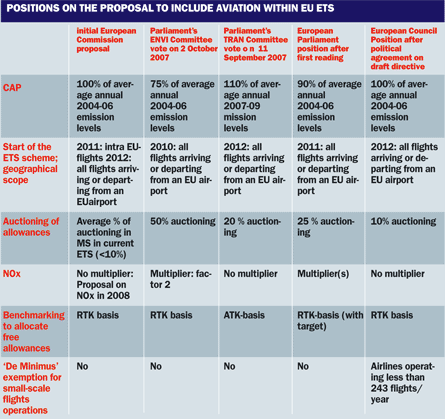This year will be crucial for aviation's eventual entry into Europe's Emissions Trading Scheme, as MEPs and member states hammer out a common agreement
A year almost since its launch, Europe's bid to go it alone and wrap international aviation within what is the world's largest carbon market certainly looks well on track to establish a new era of regulatory exposure for the airline industry.
The European proposal to include aviation in the EU Emissions Trading Scheme (ETS) is, for now, in a state of flux, however, with much of the critical detail that will determine the technical design elements of the scheme due to be hammered out thoughout 2008.
Subject to agreement between the European Parliament and the EU member states meeting in the Council of Ministers, MEPs went first and voted in November, presenting an outline of their vision of how the industry should be treated within the wider scheme. That was followed in December by the European Council issuing its own Political Agreement between member states.

The European Parliament, as expected, took a far tougher stance on the original proposal crafted by the commission, wanting to include both intra-EU and third-country flights in the EU's scheme from the earlier date of 2011 rather than a phased two-stage approach.
While the commission had proposed capping ETS allowances for CO2 emissions at 100% of aircraft operators' average annual emissions during 2004-2006, the parliament attempted a compromise between its own environment and transport committee, settling on a reduction of the number of ETS-authorised emissions to 90% of the baseline.
And whereas the commission proposed no concrete values for the number of permits to be auctioned, the parliament did so, deciding on an initial figure of 25%.
The ETS allocates a number of permits to operators, each giving them the right to emit one tonne of carbon dioxide per year. The total number of permits sets a limit, therefore, on the overall emissions from scheme participants.
Cost-effective
While some permits are allocated to operators free of charge, others are traded freely (auctioned), to allow emissions reductions to be made where they are most cost-effective.
The Association of European Airlines delivered a swift judgement on the outcome of the vote, branding it a massive blow to the viability and competitiveness of the European airline industry and a "barely measureable" step for the environment.
"This vote reflects political compromises more than it does the reality of the environmental challenge and aviation's real contribution to the issue - not to mention the fact that it is not based on any kind of impact assessment," says Ulrich Schulte-Strathaus, AEA secretary general.
He believes the parliament's decision to make airlines auction for 25% of their emission permits is a euphemism for taxes. "Airlines and the travelling public are expected to provide national treasuries with additional funds, without any guarantee that these will be invested into environmental improvements," he says.
As expected, member states on 20 December rejected in essence most of the parliamentary revisions that in their opinion smacked of carbon market distortion and/or overly punitive treatment of the airline industry. Even so, Europe's environment chiefs in delivering their collective state-level response to the original proposal, one which set itself in stark contrast to the more ambitious green agenda of the parliament, still went further in some aspects than the commission originally proposed.
All airlines flying into EU airports should, the council said, join the scheme in 2012, something that would send out "a very political signal" that Europe was serious about its efforts to tackle aviation's small but fast-growing impact on climate change.
The council, however, fell into line with the commission's original proposal that airlines should maintain emissions levels at average 2004-06 levels, with 90% of carbon credits distributed for free, something that was bound to disappoint parliament and environmentalists alike who both fear airlines will simply make windfall profits by passing on non-existent costs.
No measures were proposed for dealing with the additional climate impact caused by nitrogen oxide (NOx), whereas MEPs wanted the value of carbon credits bought by airlines doubled in the absence of specific new legislation.
Interestingly, the council wanted airlines with very thin routes to, from, or within the EU to be exempt, allowing operators from developing countries and those operating publicly subsidised routes to far-flung EU regions to opt out of emission trading. Also, it recommended that 3% of the total number of sector carbon credits be set aside in a special reserve for new entrants or for very fast-growing airlines.
The next legislative hurdle will be for the council to convert the Political Agreement into a formal Common Opinion, although given that the vision of the parliament and council are currently at such variance, ministers will effectively kick-start a parliamentary second reading in 2008 before the legislative portfolio stands any chance of being rubber-stamped by member states.
Amy Spenlove-Brown of the Brussels-based leisure carrier member organisation the International Air Carrier Association also raises the alarming spectre of profoundly shifting sands obscuring the policy landscape.
Directive review
"Crucially, in parallel to these discussions, the commission has launched a proposal to review the ETS directive which applies to other industrial sectors over the last two years.
"This will have a significant bearing on how aviation will fit into the scheme in the future. As the plans were only published on 23 January, it is however difficult to ascertain quite what impact this will have on the aviation sector's inclusion and the progress of the co-decision process.
"However, this review process looks like it will only deal with the level of auctioning, cap and the access to alternative auction markets from the year 2013," she says.
IACA and other aviation associations stress that they remain in favour of aviation's inclusion if the scheme is well designed, affordable and covers only CO2 emissions and does not include a multiplier, is non-discriminatory, allows for aviation growth, is based on an open trading system linked to the ETS market and is manageable for all airlines in the scheme.
Punitive
"The recent decisions by the European Parliament and the European Council do not fulfil any of these. The European Parliament design is particularly punitive, with 25% auctioning and is based on a de-facto "closed" trading system with the existing ETS market," she says. "The European Council's decision to exempt operators flying 729 flights per year also gives a de-facto advantage in favour of some non-EU carriers," she says, although she admits that at the moment, there has been no published assessment of the number of airlines that might be exempted.
Most worrying, however, for organisations like IACA is the likelihood in a revised ETS regime of 100% auctioning by 2020. "Policymakers have failed to understand the business model of aviation. IACA remains concerned that one of the commission's primary assumptions for the ETS scheme is wrong: that airlines are able to pass costs onto their customers.
"The ability to pass costs on is limited due to the airlines' business model and exposure to competition. A study by Mott McDonald in November 2006 for the Commission confirmed that that 30% of airports in Europe are at full capacity, with this expected to rise to 50% in 2025," says Spenlove-Brown.
Airline organisations would level that the cost pass-through at congested airports is zero simply because prices are at a maximum and no further costs can be passed on. This leads to airlines absorbing the costs and puts severe downward pressure on margins that are already small.
IACA and others have called for a serious and in-depth analysis of the inclusion of aviation into the ETS because they fear the costs of the scheme, particularly with full auctioning, just cannot be accommodated by today's European aviation sector, resulting in downsizing, bankruptcies and job losses.
While it is difficult for carriers to prepare for new rules until they know what the legislation will look like, many suspect that the airline industry is largely failing to prepare for the impact of the extension of the EU emissions trading scheme. A survey of 20 European airlines by PricewaterhouseCoopers found that only a quarter had carried out any meaningful assessment of the business impact of climate change legislation.
Even so, Hans Schoolderman, global carbon assurance leader at PwC, says that airlines are missing out on potential competitive benefits by not only failing to plan for the legislative changes but also by not shaping the future legislation through active lobbying efforts. "Aircraft operators could benefit from being more proactive now while they still have the opportunity to participate in the debate and influence the final shape of the rules and market dynamics," he says.
Melinda Harris is senior economist at ICF International with extensive experience of internalising sustainability under carbon constraints. ICF is currently working with aviation consulting firm Simat Helliesen & Eichner to combine aviation sector and carbon market modellng capabilities in an effort to jointly develop a white paper on the implications of the different emissions trading systems being proposed around the world.
Winners
Harris says that early analysis - based on hypothetical fleet assumptions - suggests that the winners in the airline industry are likely to be different under different emissions trading regimes. She points to the leading Lieberman-Warner bill in the USA, under which carriers with the most fuel efficient fleets could easily realize a competitive advantage.
"Under the proposed EU ETS, depending on how the baselines are established just the opposite could be true ie EU carriers operating older fleets could find it easier - less costly - to comply with EU requirements and end up with an advantage over competitors that are servicing the same markets," says Harris.
"There will be winners and losers, but like every other sector, aviation firms are more likely to be among the winners if they are prepared than if they just assume the outcome is inevitable or trust that they will figure out the best course of action once carbon constraints are actually in place," she warns.
Source: Flight International

















